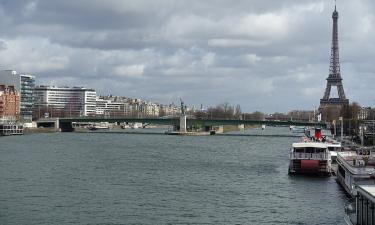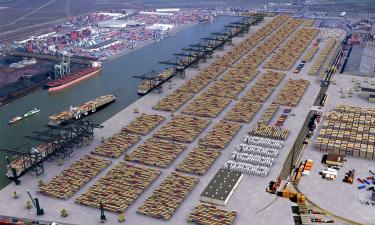Stanislavsky's Business System
His recommendations can help achieve success in business and private life William Shakespeare wrote: "All the world is a stage! And all the men and women are merely players! They have their exit and entrances." This is a story about a man the story of whose life proves this saying.
At the World Industrial Exhibition in 1900 in Paris, the gold Grand Prix medal was presented to the Russian society "V.Alexeyev, P.Vishnyakov and A.Shamshin" which became quite a sensation. The medal was presented to the society for a new sort of gold-embroidery threads which were thinner and softer than the best threats ever produced in the world. Chairman of the society's board Konstantin Sergeyevich Alexeyev, engineer Alexeyenko-Serbin and more workers of the Russian gold thread factory were awarded medals at the exhibition.
This was a sweeping breakthrough. In the early 1890s, the Russian gold thread industry was considered the most retarded in Europe; France, Italy and Germany were the leaders in the sphere. Product of these countries was better and cheaper than Russia's. There were about 20 gold thread factories in Moscow of that time. The demand for gold and silver threads was always stable, which cannot be said about production of such threads here in this country.
The early 1880s were marked with a grave crisis in the Russian gold and silver thread industry. Russian gold thread industry still operated outdated machines and technologies which made it no competitor to foreign industries.
The old Russian family of merchant Alexeyev had a share at a gold thread factory. At the beginning of 1882, son of one of the factory owners, Konstantin Alexeyev came to work in the factory's office. He was 19 and just graduated from the ninth form of the high school. The young man preferred factory work to further studies at school and institute. However, he soon got disappointed with office work, as he mostly liked technology and production. As a successor, he wanted the factory prosper and flourish. In several years Konstantin Alexeyev was appointed director of the firm which gave him a wonderful opportunity to realize his plan. The young director started through studies of the whole production line; he spent majority of his working day in the workshops and talked to workers.
Konstantin Alexeyev understood perfectly well that factory machines were already outdated, that is why he planned to modernize the production. In the spring of 1892 he went abroad to study foreign experience in spinning of gold and silver threads. Although the Russian merchant was warmly received abroad, foreign industrialists reluctantly shared their experience. Konstantin Alexeyev even had to give bribes sometimes to get some information important for the production process. With all facts and information Konstantin collected during his foreign trip he hoped to radically change the Russian production of gold and silver threads.
When Konstantin Alexeyev got back to Moscow on May 14, 1892, an acquaintance of his who was actor in the Maly Theatre met him at the railway station. The actor said the troupe of his theatre was leaving for a tour to the Russian city of Yaroslavl. But performer of the leading role fell ill and nobody could substitute him. The whole of the theatre pinned great hopes on Konstantin Alexeyev who was also known as Konstantin Stanislavsky, a very talented actor, in the artistic world. He assumed the name Stanislavsky in 1885, under this very name is he still known as the genius of the Russian and world theatre culture.
Later Stanislavsky told that although he felt very tired after his tour abroad with a view to obtain knowledge about gold thread spinning, he couldn't refuse to go to a tour with the theatre troupe. He didn't even meet with the family who were waiting for him at home. In the evening of that very day, he wonderfully performed the role of artist Bogycharov in a play written by Vladimir Nemirovich-Danchenko, Stanislavsky's future colleague in the Moscow Arts Theatre (later was called MHAT).
Cousin of Konstantin Stanislavsky was extremely displeased with the theatre activity which, as he said, seriously hampered the family business. But in fact, theatre caused no harm to business. Stanislavsky had enough time to be efficient everywhere, in the theatre and at the factory. It even seemed that the factory helped his theatre performances and the stage helped the business. There was no discord between the artistic life and the prose of the everyday life.
Business is also art. Art on the whole obeys laws which are common for all kinds of art. Konstantin Stanislavsky made his debut at the age of 14 in the home theatre. By 1888, Stanislavsky performed about 40 roles, he participated in 20 theatrical performances. That very year Konstantin Stanislavsky became one of the founders of the Moscow art and literature society which further became one of the centers of Russian culture. Stanislavsky acted on the stage and staged great plays; he learnt theatrical experience from stage masters and considered a lot of issues connected with theatre. The society existed for ten years, this was exactly the period when business activity of Konstantin Stanislavsky was especially successful. When Stanislavsky was so much preoccupied with his theatrical activity, the factory business became some kind of a burden for him. That is why he started working on developing new conditions of the factory work. At the end of 1893, Stanislavsky submitted a plan for technical reforming of the factory to the board of directors. The plan included radical solutions which were based on modern scientific achievements and technique. The project on the whole supposed to create the largest gold thread spinning production that ever existed in the world. Konstantin Stanislavsky recommended to consolidate the factory of Alexeyev with the factories of P.Vishnyakov and A.Shamshin and to build lots of important facilities. Stanislavsky offered to introduce new modern machines which could increase the productivity ten times.
In the evenings, after the intense work at the factory, Stanislavsky got pleasure from theatrical performances of the plays by Russian playwright Alexander Ostrovsky and by K.Gutskov. Those were plays performed in tours of the Maly Theatre in the Russian city of Tula, and Stanislavsky had to spent a lot of time travelling between Moscow and Tula.
Stanislavsky hoped to introduce a machine with 14 diamond drags into production of gold and silver threads. Drags of this kind were stronger than that of steel and cast iron thousands times. As the diamond drags were not produced in Russia, it was very expensive to get them from abroad, France and Italy. However, the demand for diamond drags was increasing in the country. Konstantin Stanislavsky decided to open diamond production which cost him much spending and years of hard work. A diamond workshop was started in 1894, but at first it just ground worn diamond drags, didn't produced diamond drags of its own. But that was a considerable achievement all the same as the factory didn't need to send drags for repair abroad.
Early in 1899 the board of the factory decided to open a workshop for diamond drilling. Two French specialists were invited for work in Russia. The new diamond workshop was of great importance for the whole of the enterprise.
Stanislavsky devoted five years of his life to the diamond workshop. But over the same period he created 14 wonderful stage characters. Those were roles in performances of plays by Shakespeare, Ostrovsky, Hauptman. At the same time, Konstantin Stanislavsky staged passages from popular operas by Tchaikovsky, Glinka, etc. He was working on creation of a new theatre. Later Stanislavsky wrote about this idea: "That was a revolutionary idea. We protested against the old manner of performance, against false pathos, declamation, against dramatic artificiality, bad conventionality of stage performance, against the scenery, against the whole structure of performances and against the worthless theatre repertory of that time."
On the first night of October 14, 1898, a play based on the tragedy by Alexey Tolstoy "Tsar Fyodor Ioannovich" was staged. The performance started with the significant and prophetic words: "I strongly rely upon this business." Those very words gave a start to glorious triumph of MHAT which is still one of the best theatres of the country.
At the factory and on the stage Stanislavsky persistently worked on the fundamentals of new theatrical art which was later called Stanislavsky's system. The system is based not upon study of final results of creative activity, but on revelation of causes of this or that result.
Konstantin Stanislavsky arrived at a very interesting conclusion saying that if a man wants to achieve success on the stage, he must knowingly influence creative processes in the subconsciousness. This is very similar to recommendations given in booklets helping to achieve success in private life and in business. The system teaches actors to reincarnate organically into an image invented by the author and grasped by the producer. As goes from the Stanislavsky system, stage action is a psychophysical process that mostly depends upon a man himself. Indeed, our everyday life is in fact a derivative of our mood, health, doings, etc. So, the Stanislavsky system is very useful not only for actors.
In 1898, Konstantin Stanislavsky handed his factory business over to his devoted colleagues and entirely plunged into the work at MHAT. However, the gold thread spinning business started by Stanislavsky kept on prospering. In 1905, the factory started production of electrotechnical wires, then it opened production of cables and wires. In the Soviet era, specialists from Stanislavsky's factory helped develop production of tungsten threads for electric lamps. The diamond drags produced at the factory were later used in electronics. So, while watching TV or working at your PC, remember Konstantin Stanislavsky. This is his last entrance to the stage.
Mikhail Azarov
Russki Focus
Subscribe to Pravda.Ru Telegram channel, Facebook, RSS!





